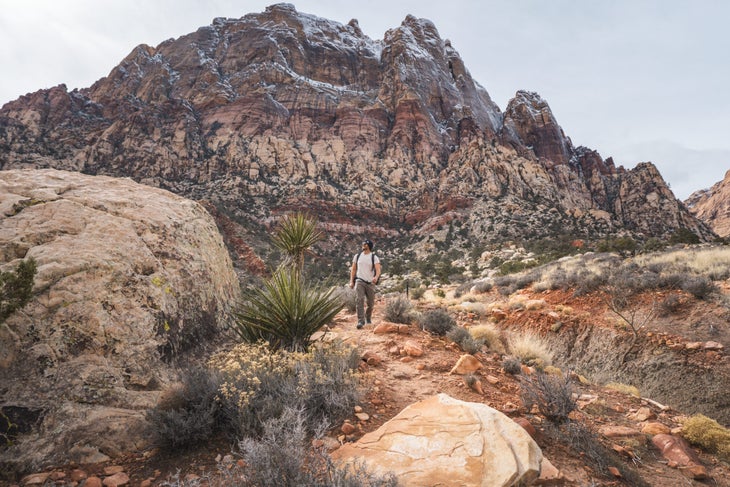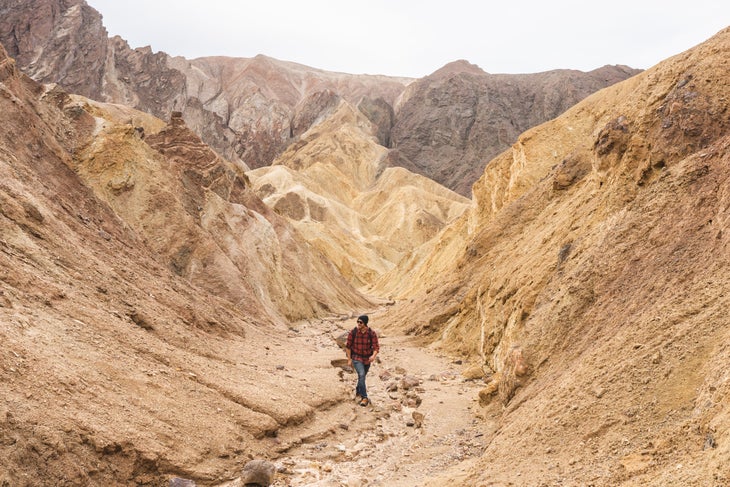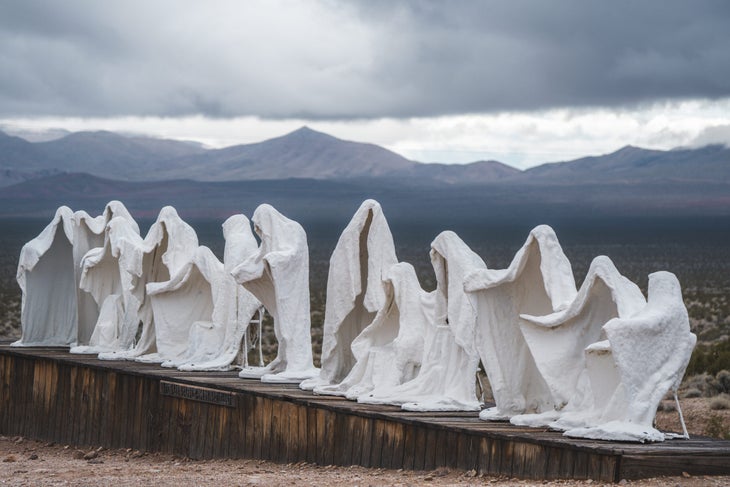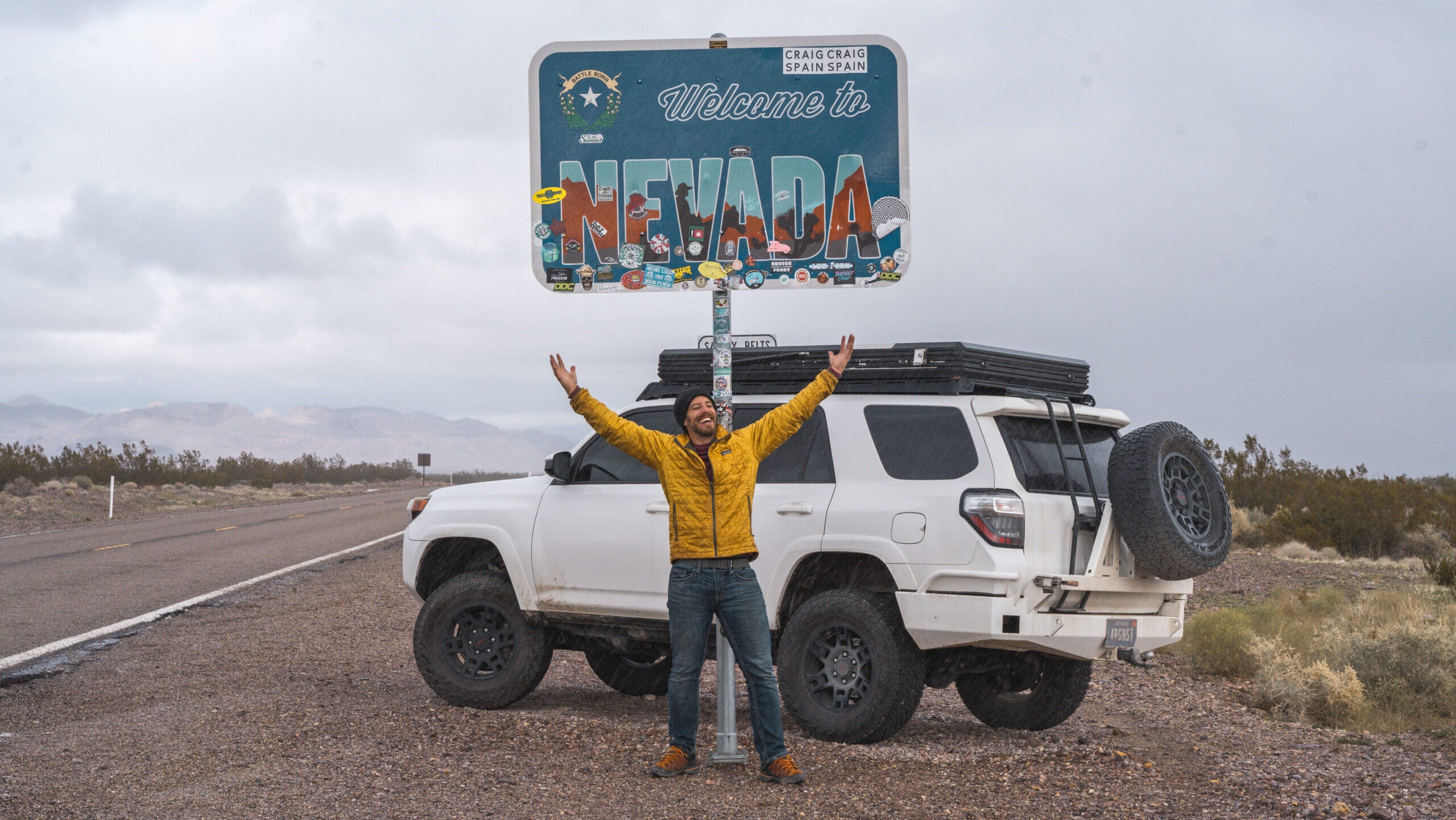Las Vegas gets the spotlight, but there’s a whole other side of southern Nevada, where backroads, outdoor adventures, and hidden gems await. This part of the Mojave Desert has always called to people who are looking for something a little different. Drive the quiet, expansive highways on the Death Valley Rally, an adventurous road trip route between Las Vegas and Death Valley National Park, where you’ll discover desert oases, wildlife refuges, charming Old Western towns, and places that can only be described as a little out there. Outside sent traveler and photographer Jacob Moon on a one-of-a-kind adventure in Southern Nevada. Here’s everything he got to experience.
Trade Neon Lights for Starlight
Drive 30 minutes from Las Vegas and you’ll be stunned by how encompassing the surrounding desert feels. Red Rock Canyon National Conservation Area is a popular destination for outdoor adventures—so popular that visitors need to reserve an entry time in advance. No need to join the crowd. Skirt around Red Rock Canyon to explore the neighboring slice of public land at Spring Mountain Ranch State Park.
This beautiful and lush oasis sits at 3,800 feet and has long been a respite from the desert heat—first for the Southern Paiute and later for pioneers heading west on the Spanish Trail. Area ranchers also took advantage of the spring to raise cattle, sheep, and, at one point, chinchillas. Stop by the historic Main Ranch House to get a map before heading out on the 1.2-mile Sandstone Canyon Loop where you’ll encounter a variety of desert flora and impressive views of the surrounding mountains. Be sure to make it back in time for free yoga classes on the massive lawn that’s supported by the park’s six natural springs. Then, stick around for an evening stargazing talk hosted by the Las Vegas Astronomical Society, which brings telescopes along for the occasion.
Tip: Still want to catch a glimpse of Red Rock Canyon? Take State Route 159 to Spring Mountain Ranch State Park. The overlook near mile marker 10 features amazing views of the sandstone mountains, no reservations required.

Make More Than a Pit Stop in Pahrump
With a population of around 40,000, Pahrump feels like a metropolis compared to many of the tiny towns you’ll pass through in southern Nevada. But this midway point between Las Vegas and Death Valley National Park still delivers on small town charm—and quirkiness, like the coffin-themed roadside attraction, Coffinwood. Although Pahrump is only an hour from Las Vegas, it didn’t have any paved roads until 1953. Today, the town has earned some fame for its off-road scene, so don’t hesitate to kick up some dust on hundreds of miles of OHV trails throughout Pahrump Valley.
Back in Pahrump, take advantage of the city amenities, including casinos, a variety of restaurants, and Pahrump’s thriving wine and spirits scene. Enjoy a wine tasting at Sanders Family Winery—the first winery established in the area—or sample cider and mead at Stonewise Mead & Cider, one of only a handful of meaderies in Nevada. If spirits are more your style, head to Desert Cane Distillery, which is known for its craft rum and cocktails. Moon also recommends a stop at the Pahrump Museum. “The museum staff are extremely knowledgeable about the area’s history, which gives great context to the places you explore outside of town.
Tip: Before you hit the road, fill your bellies at O Happy Bread, a local favorite known for its croissants and pastries. Then, fill your gas tank. Service stations are few and far between in this part of Nevada.

Venture Into the Mountains
Southern Nevada isn’t all desert landscapes broken up with water-rich oases. Just 45 minutes from The Strip, Mt. Charleston is the perfect place for cool temperatures and alpine adventures. Just shy of 12,000 feet, Charleston Peak is the highest summit in southern Nevada and the eighth highest in the state. Take a spin at the small-but-mighty Lee Canyon Bike Park, which opened in fall 2022. Currently, the park has five lift-accessed downhill trails, with plans to expand in the coming years. The 4.2 miles of trails offer a good time for all levels of riders. In winter, Lee Canyon makes the transition to fun, skiable terrain.
Prefer to explore on foot? Hike more than 60 miles of forested trails in the area. Most trails start at around 6,000 feet in elevation, so you’ll be able to tackle longer distances without the desert heat to contend with. For a challenge, hike the 17-mile Mt. Charleston National Recreation Trail. The strenuous route climbs 4,890 feet to the summit, where you’ll be rewarded with 360-degree views of the surrounding pristine desert and Las Vegas in the distance.
Tip: The view of Mt. Charleston from the desert is equally impressive. “During my trip in February, a snowstorm enveloped Mt. Charleston. When the clouds cleared, I was left with a stunning view of the snowy mountain massif from the surrounding desert landscape.”
Explore Death Valley National Park, Of Course
It’s true—southern Nevada is the gateway to Death Valley National Park. You’ll be close to the otherworldly preserve on this tour and you shouldn’t miss it. Drive through Twenty Mule Team Canyon, a three-mile, one-way loop through mudstone badlands. If temperatures aren’t too hot, this route is also great as a bike ride. Either way, hike to Zabriskie Point, which offers a must-see view of one of the most-photographed landscapes in the park. Learn how to protect the park’s fragile ecosystem and prepare for the extreme seasonal temperature changes by stopping at the Furnace Creek Visitor Center to chat with a park ranger.

Another scenic route worth taking: Artist’s Drive. This nine-mile route leads to the colorful hills of Artist’s Palette. A variety of compounds in the volcanic rocks causes the rainbow effect. From there, head back to Badwater Road to drop down into Badwater Basin, the lowest point in the United States. “I’ve visited Death Valley many times, and the desert always provides a unique experience,” says Moon. “On this trip, I got to see the Bad Water Basin like I’d never seen it before. An atmospheric river had flooded the basin creating the massive, temporary Lake Manly. The reflection of the snow-capped mountains in the water is something I’ll never forget.” Once you’ve fully explored the park from top to bottom, make your way along State Route 190 back toward Beatty. Or take Hwy. 373 to Amargosa Valley for a special treat: a photo op with Big Bovine, a 12-foot tall cow statue.
Tip: Keep an eye out for wild burros as you head to Beatty. They typically travel in herds in the hills around this area and are sometimes the cause of “burro jams” as they cross the road.
Tour an Artsy Ghost Town
Only in Nevada will you find a sprawling sculpture park right next to a ghost town. In the early 1900s, the discovery of gold ore led to the establishment of Rhyolite, a town that boomed for a few years before the bust hit almost as quickly. By 1920, Rhyolite was all but deserted. Today you can explore remnants of the original Rhyolite, including the old bank building, jail, and train depot. Don’t miss the ghost town’s pièce de résistance: Tom Kelly’s Bottle House. Constructed in 1906, the residence was made from 50,000 discarded beer and liquor bottles. Although the novel choice of building materials was due to cost-effectiveness—with lumber in scarce supply in the desert, glass was a cheaper building alternative—rather than style, the Bottle House is quite the work of art. The building was even restored a couple decades after Rhyolite’s heyday to have its moment in a movie.
You’ll find more art at the Goldwell Open Air Museum next door. Spanning eight acres, this outdoor sculpture park is full of memorable sculptures created by a group of Belgian artists who were drawn to the Mojave Desert as a place they could have full artistic freedom.

Tip: Grab dinner at the Happy Burro, one of many historic sagebrush saloons across the state. Then, hit Eddie World—a quirky gas station offering long aisles filled with every type of candy imaginable, many of which are made on-site.
Discover the Desert’s Biodiversity
Life thrives in Nevada’s desert—if you know where to look, that is. Explore a thriving desert ecosystem at Ash Meadows National Wildlife Refuge. The largest oasis in the Mojave Desert, this preserve is home to incredible biodiversity. At least 24 plants and animals found in this refuge aren’t found anywhere else in the world. Stop by the visitor center to learn about the area, then head to Devils Hole, an underwater cavern with depths of up to 900 feet. With the help of binoculars, you might see the endangered Devils Hole pupfish from the viewing platform above the cavern.
For a more macro wildlife experience, head to the Desert National Wildlife Refuge, a habitat for desert bighorn sheep. This massive preserve— the largest wildlife refuge in the contiguous United States—is more than double the size of Rhode Island. The refuge’s 800-1,000 bighorn sheep tend to spread out in smaller herds; ask a ranger for tips on spotting these elusive desert dwellers.
Tip: Throughout the refuge, keep your eyes out for petroglyphs from the Southern Paiute, who’ve resided in southern Nevada since as early as 1100. Please remember to never touch petroglyphs.
Travel Nevada (the Nevada Division of Tourism) is part of the Nevada Department of Tourism and Cultural Affairs. It is responsible for promoting and marketing Nevada as a travel destination.

